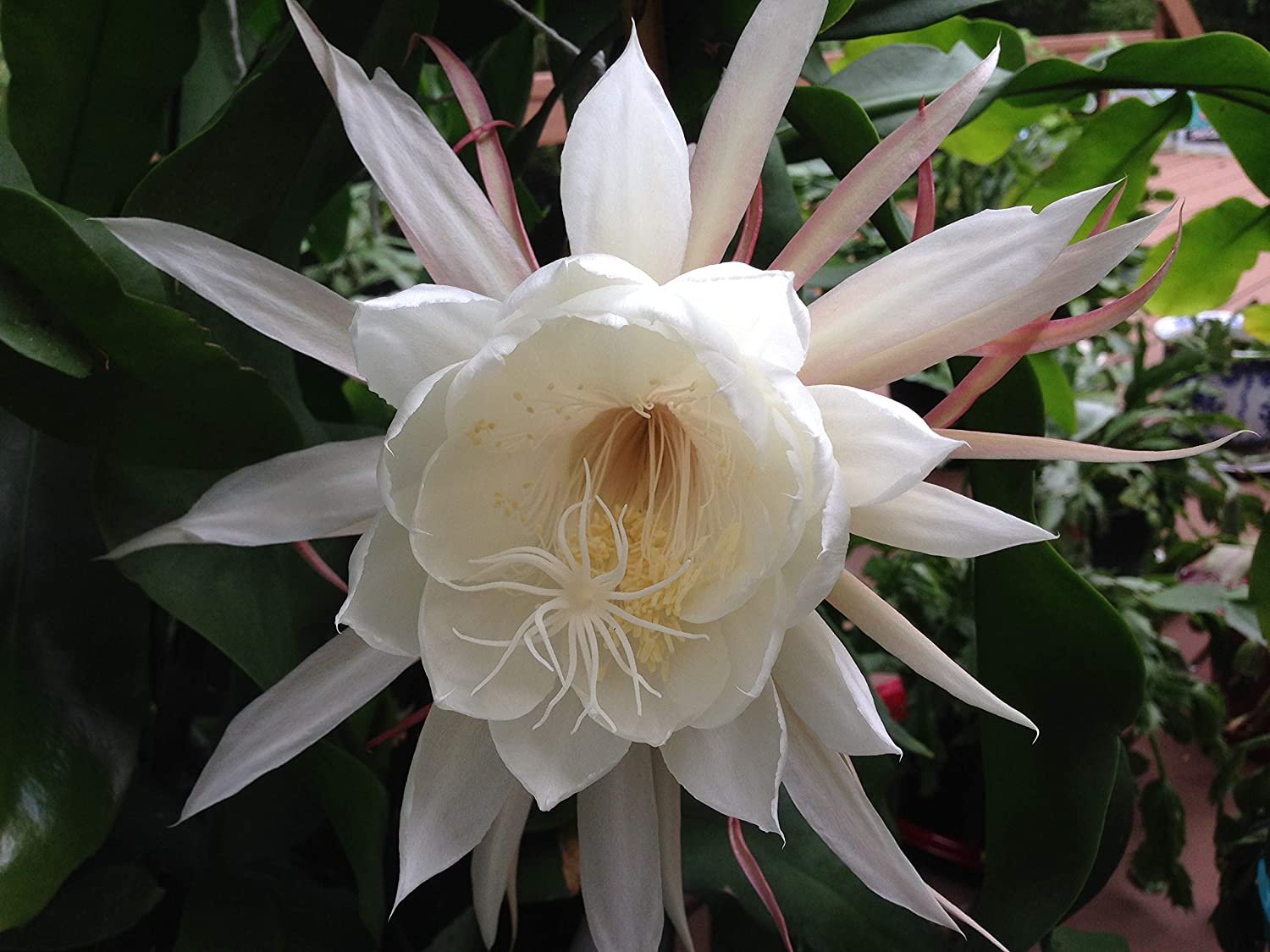The Epiphyllum Oxypetalum, better known as the Queen of the Night Orchid is an ornamental plant that is one of the extensively cultivated cacti in its subdivision.
You must be wondering why is it called the queen of the night orchid. Let me tell you the secret – the beautiful and elegant white flowers of this plant bloom only during the night time and the aroma that it renders will have anyone feel its mightiness.
Every day a new floret is born from the bud and if you stay during its flowering period you will certainly witness a lot of the majestic blossoms bloom.
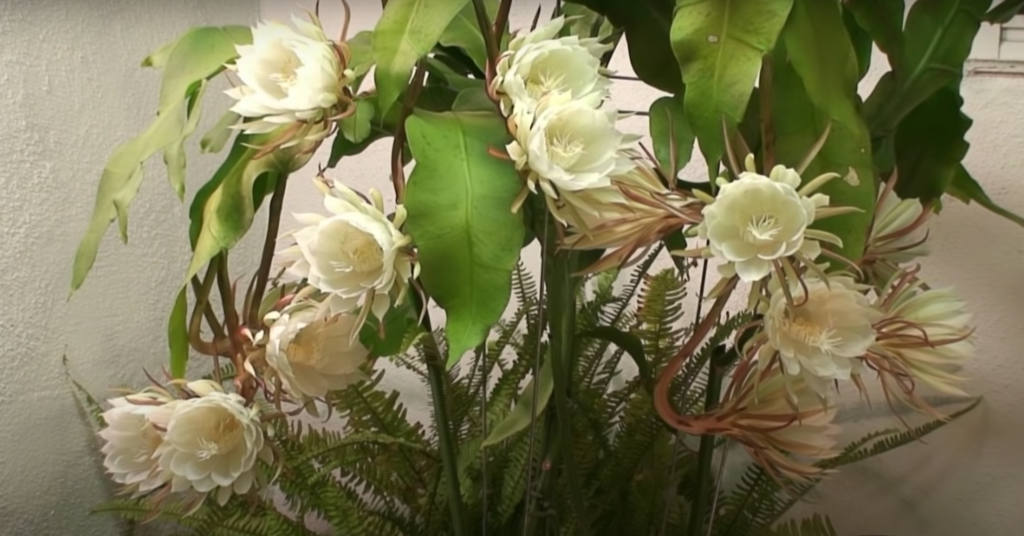
This plant is also known as Brahmakamala. It is one of the sacred flowering cacti is Hinduism. Blooming this flower is a sign of goodwill and prosperity according to their beliefs.
How to uniquely identify the Queen?
This tropical plant is nocturnal by nature and usually blooms after dusk and it faints before dawn. But the most striking thing is that these plants (if you have more than 1) bloom at once.
Wondering why such a thing happens? Well, it is because of the need to reproduce by cross-pollination as the queen of night orchid is not a self-fertile cactus.
How big does it grow?
The plant grows between 3 – 6 meters and has lateral flattened green stems with a lumbar base. The queen of the night flower is 30 cm in length and 17 cm in width growing on the stems.
It grows like a slender and woody plant irregularly spreading its territory. However, this can be potted easily or placed on the window pane.
Where can you find them?
The epiphyllum oxypetalum has its origin in the deep rainforest of Mexico, precisely Southern Mexico. It can also be found in the southern region of North America and also in Central and South America.
Apart from this, you can find it throughout the globe where is it known by varied names like the ‘Dutchman’s pipe’, ‘Wijaya Kusuma’, ‘Bramhakamal’, ‘Gekka Bijin’, etc.
The Flower, the Leaves, and the overall look

The Queen of Night Orchid blooms only after the plant has become mature which may take several weeks. The inner tepals of the flower are whitish in color and the outer ones have a reddish hue and then sometimes you get to see a pale yellowish touch on the white petals.
Are you wondering how long an epiphyllum oxypetalum flower lasts? To be specific the blossom lasts for a few hours only, around 4-6 hours or less, at night.
Branches grow from the lean base of the plant with the flowers obtruding through the tip.
The leaves of the epiphyllum oxypetalum are sleek and are not of the kind that you usually find in a cactus. Appearing to be like a leaf, they are actually the improvised stems of the plant. These items are usually utilized by the plant to store water in dry conditions.
Can I opt for an Indoor plantation of this cactus species?
The is one of the widely grown indoor plants and can easily fit into your roof-top garden. The plant likes being bounded by its root and thus making it an easy option to be potted. You can choose hanging plant pots for epiphyllum oxypetalum as it looks nice or you can also place them on the window pane.
Are you thinking about where to buy epiphyllum oxypetallum from? The flower is one of the best suited for your home garden and you can easily find it in the marketplace within an affordable range.
You can also choose to grow it outdoors and pick the blooming blossoms and keep it in your house spreading its esthetic smell throughout your house.
What are the essentials to its growth?

You will always like your plant to grow to its fullest and bloom the most in a season. To achieve this, you need to be very caring towards it during its growing phase.
Let us know in detail how to take care of epiphyllum oxypetalum and what should be on our to-do list for successfully growing the orchid cactus queen of the night.
The Soil
As we already know that the queen of the night cactus is a descendant of the Mexican rain forest, therefore, the soil unlike that of other species from its family requires to be moist. But remember that the soil must be dried before and after watering sessions.
The soil should also be nutritious to help the plant grow. Give it a good mixture of moss and shredded redwood bark at the base with a 4: 2 ratio of sand to help the drainage of excess water. You can also try mixing perlite and chopped bark in a similar proportion.
Tip for the day – The epiphyllum oxypetalum attains good growth in acidic soil having a pH of 5 – 6.
Potting the queen
Despite requiring moist soil, the drainage system requires special attention. The potting of the epiphyllum oxypetalum thus come into play. You can opt for plastic pots with a center drainage hole and up to 6 inches in height.
You can go for a hanging pot which would make the queen look more elegant. Since the plant likes to be root bounded, you can also opt for compact round pots.
Watering the plant
Watering epiphyllum oxypetalum is very critical to nurturing your queen of the night orchid. No need to water it every day and overwatering might cause its root to rot. Ensure that the soil is completely dry before watering again. You must also refrain from letting your epiphyllum oxypetalum have completely dry soil for a longer period as its hampers its growth, always keeping them slightly moist.
During summer you need to water it once or twice a week it, while in spring it requires to be watered only once in 2 weeks. Winters are a very crucial period and you should only water the plant once in 4 – 6 weeks.
Tip for the day – While the plant starts its wilting phase, do not indulge in excess watering than the usual routine.
Right Temperature and Sunlight
The orchid cactus requires filtered sunlight as direct light is harmful. If you are planting it indoors, my suggestion will be to keep it on a south-facing window pane. In case it’s in our outdoor garden, try filtering the direct light using an umbrella or keep it under the shade of a bigger tree.
For better growth of the epiphyllum oxypetalum temperature ranging between 45℉ – 90℉ is the best suited. The queen of the night – epiphyllum oxypetalum, cannot withstand anything below 40℉ or above 100℉. According to USDA (United States Department of Agriculture) hardiness zones it is best suited for zone 10 – 11.
During winters, remember to move your queen of the night orchid to a warmer place.
Fertilizers and Pesticides
In this case, the soil mixture itself serves the purpose but if you still want to add some fertilizers, you can go for some organic ones like using dried banana peels which is a good fertilizer for epiphyllum oxypetalum growing rapidly.
Apart from this, you can also use a balanced dosage of liquid fertilizers with less nitrogen. The queen of the night orchid is prone to some fungal spots which can be treated by spraying pesticides and insecticides.
Tip for the day – Keep in proper lighting, location, and temperature to avoid bugs, mites, and snails from causing damage.
The essentials of Repotting
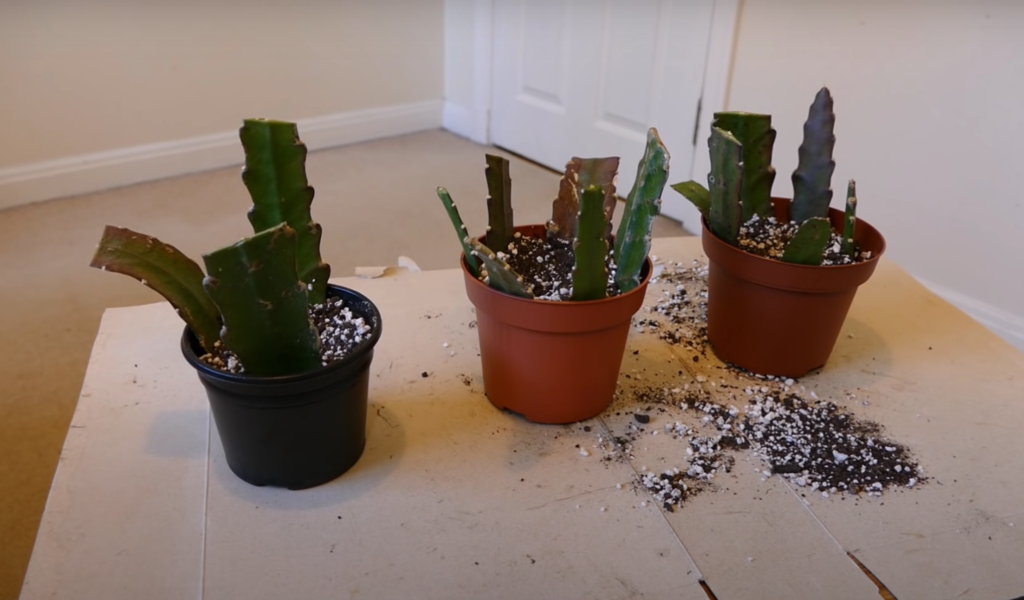
Repotting is an essential part of gardening and plantation procedures. Every plant should be repotted at least once every 5 years, sometimes before that even. Generally, this procedure is carried out after 6 weeks of blooming.
For the queen of the night orchid, it would be good if the plant can be repotted every 3rd summer. The plant needs to be moved to a new container (pot). During this phase, you have the advantage to test the root conditions and also indulging in epiphyllum oxypetalum propagation.
No need to remove the entire soil from the roots, a slight shake would serve the purpose. The new pot would contain a new soil mixture rich in plant essentials and nutrients from which the plant highly benefits.
Tip of the day – It is good to choose a bigger container than the previous one when you opt for repotting your plant.
Keeping the traits of your Queen
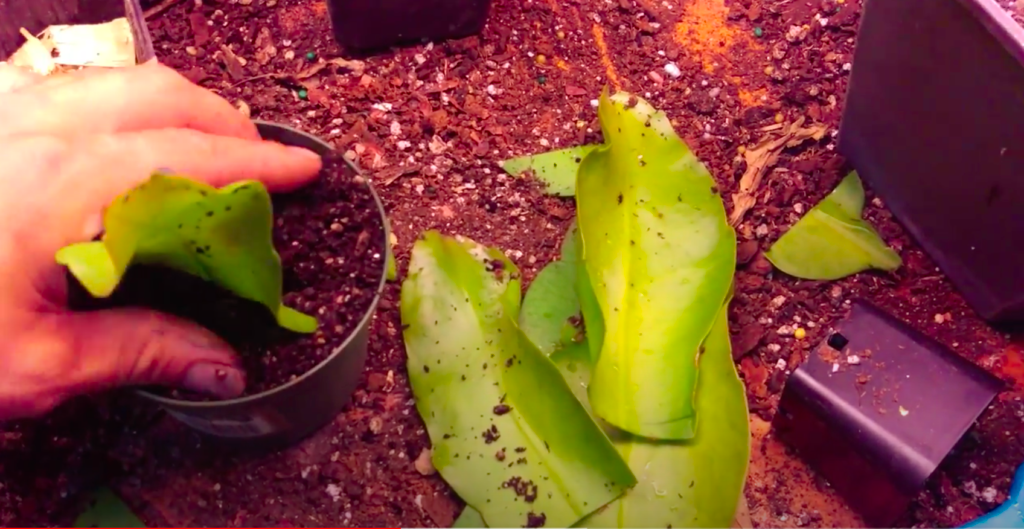
Propagation of your queen of the night orchid plant is not complex but a crucial step that must be done. This will help your plant to reproduce and you can keep its traits too. You can follow the simple steps below to do it with ease.
- Task 1: Select a leaf (maybe more than 1) and cut it around 12 cm from the tip. Keep it dry for a few days so that the tissues become hard.
- Task 2: Now dip the tip of the leaf cuttings into a rooting hormone to speed up the growth.
- Task 3: Prepare a good potting mixture in a well-draining pot (4-6 inches) and insert the cuttings.
- Task 4: The rule is the same again, no direct sunlight. Remember to water it once a week.
- Task 5: Wait for the new roots to appear which takes around 2.5 weeks.
- Task 6: Shift the new plant to a brighter spot with partial sunlight.
Tip for the day – repotting is a very important aspect of the growth and survival of your epiphyllum oxypetalum.
It is one of the most difficult tasks when it comes to blooming your queen of the night orchid and only lucky people get the chance to do it properly. You need to have good patience I must say.
You must keep the plant in a bright place within a compact potting so that it can be well root bounded. Let the roots fill your pot and remember one thing, the more the bounding the more quickly it will bloom.
Feeding your plant is also a part of the queen of the night flower care, and it is essential to provide a good fertilized meal with less nitrogen and rich organic matter.
The plant starts to flower during summer and spring around between April – August. The majestic white flowers look like a spider before blooming and once bloom the appearance is that of a star.
Tip of the day – Practice being a night owl if you want to enjoy the ecstasy of its blooming.
Taking your orchid cactus Outdoors
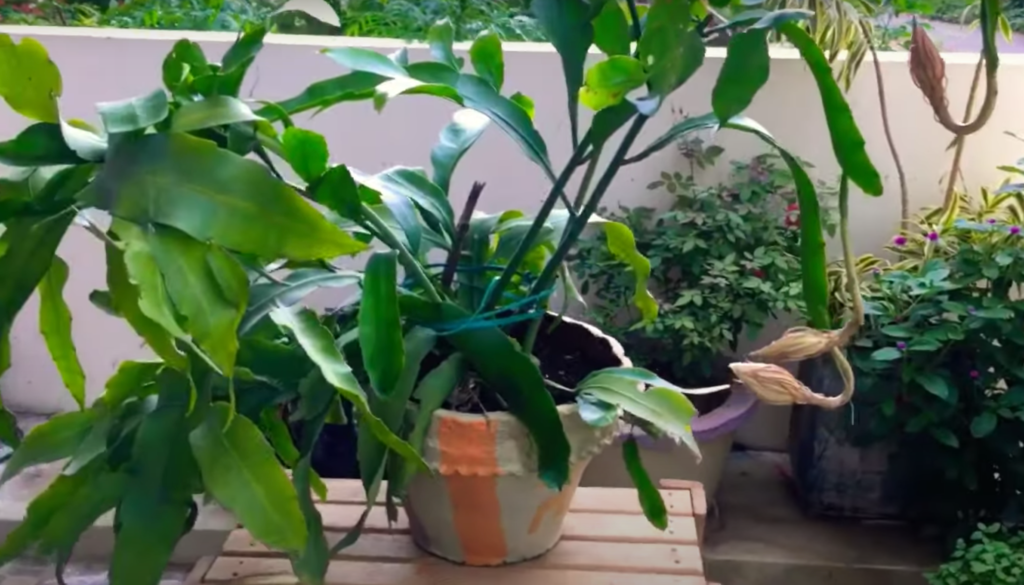
Thinking of taking your orchid cactus outdoors? Well, I must appreciate your thoughts. You can obviously place them outside your house when the weather is warm but not too warm. You can do this during the winter mainly when temperatures are low.
The outside temperature will give a good warmth to the epiphyllum oxypetalum but remember to keep it away from direct sunlight. This will also help your plant become strong by hardening its tissues.
Tip of the day – You can mesh-like structures made of bamboo, sticks, and hay to protect your epiphyllum oxypetalum from direct light.
Is the plant anyhow noxious?
People say beauty has its own charm but beauty can also be lethal at times. A thought might be lingering over your head thinking if the epiphyllum oxypetalum is toxic or not. – Well, I did not find any source claiming the same.
The queen of the night orchid is basically epiphytic and feeds on other plants. You cannot call epiphytes to be parasitic as they only imbibe moisture from the surroundings. It uses the support of other plants only.
Tip of the day – Do not worry even if you have pets, they are not at all poisonous.
Prone to Disease?
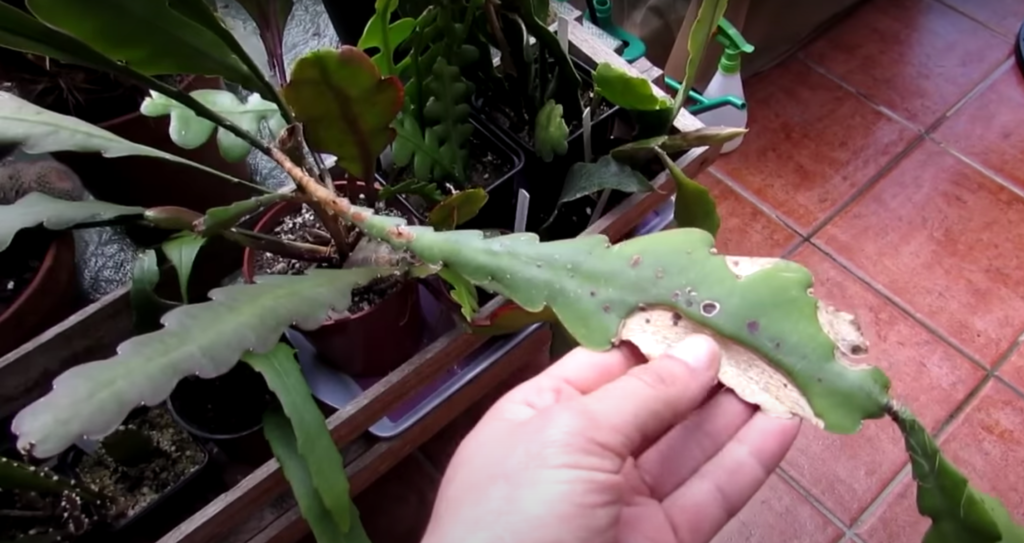
The queen of the night orchid is prone to fungal infection on the leaf. The spots appear as black patches on the surface of the leaves and can be dangerous to the plant at times.
If the number is less, you can opt for spraying a good fungicide but if the count is really high, I will recommend you cut off the unexposed part and use it for growing a new plant.
Apart from these, the roots can also be harmed or damaged by excessive watering and can result in rotting even. The plant, if exposed to an excessive temperature beyond its threshold limit, can die due to burning effects.
Are any other issues involved?
Well, there are some issues or diseases that you may selectively face depending on how you are caring for your plant. Let me list out some of them to keep you aware.
- Lower leaves turn yellow.
- Slow growth rate and soft tissues.
- Red ting on the edge of the leaves.
- No blossoms throughout the year.
Are you now a bit worried? – Well, there is no need to worry. These are only the extreme possibilities and would never cross your road if you are focused on the queen of the night plant’s care.
Tip of the day – Do not use direct water from the tap, let it stand for a while. It will be best if you can use lukewarm water since these tropical plants are quite responsive to temperature.
Does it require some extra attention during winter?
You already know that temperatures beyond 40℉ can be dangerous to the night orchid. The epiphyllum oxypetalum faces a serious threat in the winter season when the temperatures are very low.
If your plant is kept outdoors, try to bring it inside your house and you can use thick clothes or frost cloth for keeping it warm by putting it over the queen.
Try to keep it away from vents where it might get a touch of the extreme weather conditions during winter.
Does it have any medicinal usage?
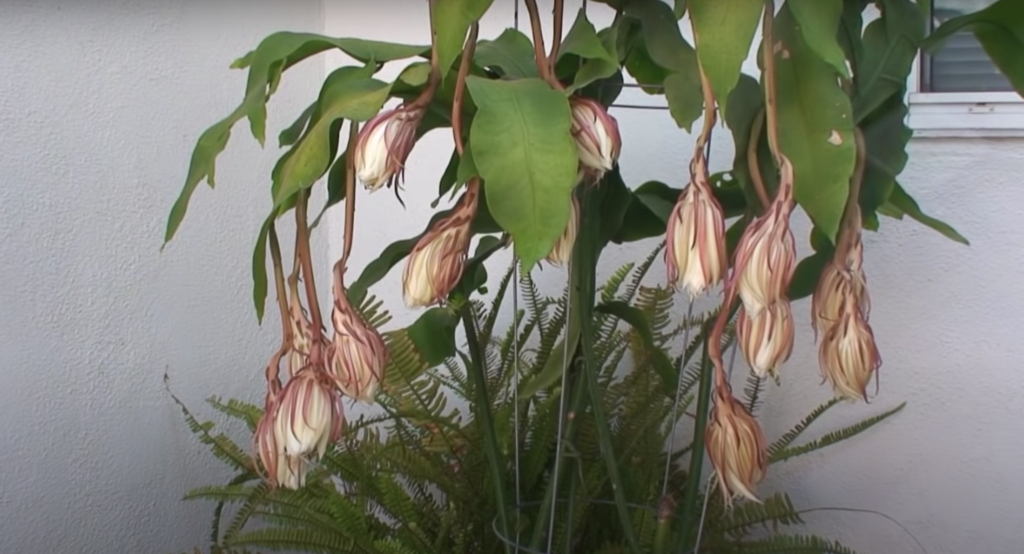
The epiphyllum oxypetalum medicinal uses to make it indeed a queen as it holds some excellent therapeutic values being from the tropical rain forest. The phylloclades possess some vital components which inherit antibacterial properties.
The stem of the plant is also useful for medicinal purposes and is considered an extensive option for curing dropsy and some infections of the heart.
In some of Asian countries, mainly Vietnam, the petals of the wilted flower are used to cook soups. The soups are thought to be having a medicinal impact similar to a tonic and can stimulate your sexual health.

The queen of the night orchid (epiphyllum oxypetalum scientific name) is basically from the family of Cactaceae although having a nature more like an orchid than a cactus.
The flowers are so astonishing that they are highly in demand during the party season. Sometimes confused as the night-blooming cereus, epiphyllum oxypetalum can also be found at flower exhibition shows.
The variety of this cactus is not among the tall ones. The queen with its succulent leaves is also a climber and can grow tall with the support of its nearby plant. This nature can be highly manipulated for decorating it in a hanging pot.
Final tip of the day – You can introduce an artificial means of humidity by using a pebble tray underneath to lock the moisture in the surrounding during dry winters.
